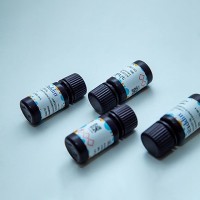Synthesis of Peptide‐Oligonucleotide Conjugates Using a Heterobifunctional Crosslinker
互联网
- Abstract
- Table of Contents
- Materials
- Figures
- Literature Cited
Abstract
Peptide?oligonucleotide conjugates (POCs) are molecular chimeras composed of a nucleic acid moiety covalently attached to a polypeptide moiety. POCs have been used in numerous applications from therapeutics to nanotechnology, and most recently as combinatorial agents in the assembly of bivalent protein affinity reagents. This unit describes the synthesis and purification of POC molecules using the heterobifunctional crosslinking reagent succinimidyl?4?(N?maleimidomethyl)cyclohexane?1?carboxylate (SMCC), which enables amine?modified oligonucleotides to become covalently linked to cysteine?modified polypeptides. This solution?based protocol consists of a two?step synthesis followed by a single purification step. Curr. Protoc. Nucleic Acid Chem. 42:4.41.1?4.41.20. © 2010 by John Wiley & Sons, Inc.
Keywords: peptide?oligonucleotide conjugate; succinimidyl?4?(N?maleimidomethyl)cyclohexane?1?carboxylate (SMCC); fragment conjugation; antisense; DNA nanotechnology; synbodies; nanodisplay
Table of Contents
- Introduction
- Basic Protocol 1: Purification of Amine‐Modified Oligodeoxynucleotide
- Basic Protocol 2: Conjugation of SMCC to the Amine‐Modified Oligonucleotide
- Basic Protocol 3: Conjugation of SMCC‐Oligonucleotide to a Cysteine‐Containing Peptide
- Basic Protocol 4: Purification of Peptide‐Oligonucleotide Conjugates Using native‐PAGE
- Alternate Protocol 1: Purification of Peptide‐Oligonucleotide Conjugates Using Reversed‐Phase HPLC
- Reagents and Solutions
- Commentary
- Literature Cited
- Figures
- Tables
Materials
Basic Protocol 1: Purification of Amine‐Modified Oligodeoxynucleotide
Materials
Basic Protocol 2: Conjugation of SMCC to the Amine‐Modified Oligonucleotide
Materials
Basic Protocol 3: Conjugation of SMCC‐Oligonucleotide to a Cysteine‐Containing Peptide
Materials
Basic Protocol 4: Purification of Peptide‐Oligonucleotide Conjugates Using native‐PAGE
Materials
Alternate Protocol 1: Purification of Peptide‐Oligonucleotide Conjugates Using Reversed‐Phase HPLC
Materials
|
Figures
-
Figure 4.41.1 Example of heterobifunctional crosslinking reagents that contain maleimide and succinimidyl ester moieties, all of which are compatible with the protocols described in this unit. View Image -
Figure 4.41.2 Amine‐modified oligonucleotide conjugation to a cysteine‐containing peptide using the heterobifunctional crosslinking reagent SMCC. View Image -
Figure 4.41.3 Amine‐modified deoxynucleotide phosphoramidite and CPG reagents available from Glen Research that can be used as building blocks to construct amine‐modified deoxyoligonucleotides. View Image -
Figure 4.41.4 Conjugation of SMCC to an amine‐modified deoxyoligonucleotide. View Image -
Figure 4.41.5 Conjugation of SMCC‐oligonucleotide to a cysteine‐containing polypeptide. View Image -
Figure 4.41.6 Reversed‐phase HPLC analysis of (A ) the c‐myc peptide (EQKLISEEDLC), (B ) crude POC material (EQKLISEEDLC‐ACCAGCTGTGCAGGCCTCGC), and (C ) 1 nmol of SMCC‐oligonucleotide spiked into the POC mixture (Williams, ). View Image -
Figure 4.41.7 MALDI mass spectroscopy analysis of (A ) SMCC‐oligonucleotide and (B ) purified POC material (Williams, ). View Image -
Figure 4.41.8 Native‐PAGE mobility shift analysis of POC material. Retardation of mobility is observed between the ssDNA (ACCAGCTGTGCAGGCCTCGC) (lane1), SMCC‐oligonucleotide (SMCC‐ACCAGCTGTGCAGGCCTCGC) hybridized to its complementary strand (lane 2), and POC (EQKLISEEDLC‐ACCAGCTGTGCAGGCCTCGC) hybridized to its complementary strand (lane 3), thereby confirming the presence of the polypeptide (Williams et al., ). Image reproduced with permission from Wiley‐VCH Verlag GmbH & Co View Image
Videos
Literature Cited
| Literature Cited | |
| Brewer, C.F. and Riehm, J.P. 1967. Evidence for possible nonspecific reactions between N‐ethylmaleimide and proteins. Anal. Biochem. 18:248‐255. | |
| Fasman, G.D. 1975. Handbook of Biochemistry and Molecular Biology. Vol. 1: 3rd Edition, p. 589. CRC Press. Boca Raton, Florida. | |
| Grandas, A., Marchan, V., Debethune, L., and Pedroso, E. 2007. Stepwise solid‐phase synthesis of nucleopeptides. Curr. Protoc. Nucleic Acid Chem. 31:4.22.1‐4.22.54. | |
| Haralambidis, J., Duncan, L., Angus, K., and Tregear, G.W. 1990. The synthesis of polyamide‐oligonucleotide conjugate molecules. Nucleic Acids Res. 18:493‐499. | |
| Harrison, J.G. and Balasubramanian, S. 1997. A convenient synthetic route to oligonucleotide conjugates. Bioorg. Med. Chem. Lett. 7:1041‐1046. | |
| Harrison, J.G. and Balasubramanian, S. 1998. Synthesis and hybridization analysis of a small library of peptide‐oligonucleotide conjugates. Nucleic Acids Res. 26:3136‐3145. | |
| Leonetti, J.P., Degols, G., and Lebleu, B. 1990. Biological activity of oligonucleotide‐poly(L‐lysine) conjugates: Mechanism of cell uptake. Bioconj. Chem. 1:149‐153. | |
| Moroder, H., Steger, J., Graber, D., Fauster, K., Trappl, K., Marquez, V., Polacek, N., Wilson, D.N., and Micura, R. 2009. Non‐hydrolyzable RNA‐peptide conjugates: A powerful advance in the synthesis of mimics for 3 prime‐peptidyl tRNA termini. Angew. Chem. 121:4116‐4120. | |
| Portela, C., Albericio, F., Eritja, R., Castedo, L., and Mascarenas, J.L. 2007. Ds‐oligonucleotide‐peptide conjugates featuring peptides from the leucine‐zipper region of Fos as switchable receptors for the oncoprotein Jun. Chem. Bio. Chem. 8:1110‐1114. | |
| Roberts, R.W. and Szostak, J.W. 1997. RNA‐peptide fusions for the in vitro selection of peptides and proteins. Proc. Natl. Acad. Sci. U.S.A. 94:122297‐112302. | |
| Singh, Y., Spinelli, N., and Defrancq, E. 2008. Chemical strategies for oligonucleotide‐conjugates synthesis. Curr. Org. Chem. 12:263‐290. | |
| Soukchareun, S., Tregear, G.W., and Haralambidis, J. 1995. Preparation and characterization of antisense oligonucleotide‐peptide hybrids containing viral fusion peptides. Bioconj. Chem. 6:43‐53. | |
| Stearns, L.A., Chhabra, R., Sharma, J., Liu, Y., Petuskey, W.T., Yan, H., and Chaput, J.C. 2009. Template‐directed nucleation and growth of inorganic nanoparticles on DNA scaffolds. Angew. Chem. Int. Ed. 48:8494‐8496. | |
| Tengvall, U., Auirola, S., Antopolsky, M., Azhaev, A., and Beigelman, L. 2003. Characterization of antisense oligonucleotide‐peptide conjugates with negative ionization electrospray mass spectrometry and liquid chromatography‐mass spectrometry. J. Pharma. Biomed. Anal. 32:581‐590. | |
| Tournier, E.J.M., Wallach, J., and Blond, P. 1998. Sulfosuccinimidyl 4‐(N‐maleimidomethyl)‐1‐cyclohexane carboxylate as a bifunctional immobilization agent. Optimization of the coupling conditions. Anal. Chimica Acta 361:33‐44. | |
| Tung, C.‐H. 2000. Preparation and application of peptide‐oligonucleotide conjugates. Bioconj. Chem. 11:605‐618. | |
| Venkatesan, N. and Kim, B.H. 2006. Peptide conjugates of oligonucleotides: Synthesis and applications. Chem. Rev. 106:3712‐3761. | |
| Williams, B.A.R., Lund, K., Liu, Y., Yan, H., and Chaput, J.C. 2007. Self‐assembled peptide nanoarrays: An approach to studying protein‐protein interactions. Angew. Chem. Int. Ed. 46:3051‐3054. | |
| Williams, B.A.R., Diehnelt, C.W., Belcher, P., Greving, M., Woodbury, N.W., Johnston, S.A., and Chaput, J.C. 2009. Creating protein affinity reagents by combining peptide ligands on synthetic DNA scaffolds. J. Am. Chem. Soc. 131:17233‐17241. | |
| Williams, B.A.R. 2010. Designing Recognition Elements Based on DNA Scaffold. Ph.D. thesis, Arizona State University, Tempe, Arizona. |




